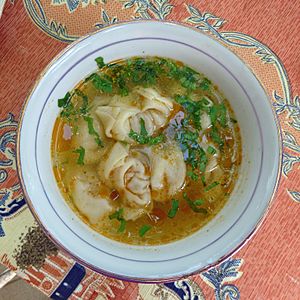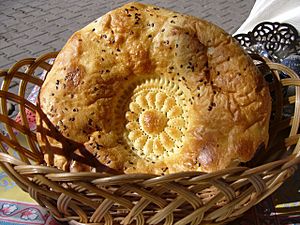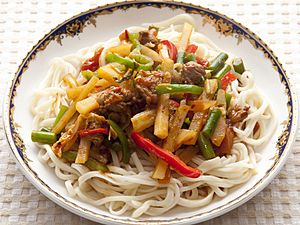Central Asian cuisine facts for kids

Central Asian cuisine is a mix of many cultures! It has been shaped by food traditions from Persia, India, Arab countries, Turkey, China, Mongolia, Africa, and Russia. Many different groups of people, like the Uyghurs, Slavs, Koreans, Tatars, Dungans, and Germans, moved to Central Asia over time. They all brought their own cooking styles and ingredients, making the food very diverse.
Contents
How Central Asian Food Developed
For a long time, people living as nomads on the Eurasian Steppe ate simple meals. Their diet mainly included dairy products like milk and cheese. They also ate some wild game and plants they found.
Cooking in Central Asia was tricky because water was scarce. People used poplar trees, saxaul plants, and even animal dung as fuel. They cooked in special ovens called tandyr ovens. These ovens were designed to get the most heat from very little fuel. In tandyr ovens, they baked flatbread, samsa (savory pastries), and meats. Soups, stews, and steamed dumplings were often cooked in a single pot.

The cooking styles of Central Asia were greatly influenced by different empires. The Persian Empire had very fancy dishes, using ingredients from as far away as China and the Mediterranean Sea. The Turkic peoples added their own touch with foods like manti dumplings, a sweet wheat porridge called sumalak, and various dairy products. Even after the Mongol invasions in the 13th century, these cooking traditions continued to thrive.
Later, the Mughal Empire, founded by Babur (a descendant of Tamerlane), brought a new level of sophistication. Mughal cooking mixed Indian and Persian styles. They used fragrant spices like nutmeg, cinnamon, and mace to flavor dishes. Meals often included thick sauces made from yogurt and crushed nuts. Their rice pilafs were very elaborate, and desserts were often flavored with rose. Many modern Indian dishes, like grilled tandoori meats and yogurt sauces, show the influence of Mughal cuisine.
What Makes Central Asian Food Special?
The food in Central Asia can be grouped in different ways:
- Nomadic or Urban: Nomadic people who moved around ate more meat and dairy. City dwellers had access to more ingredients.
- Highland or Lowland: What grew locally affected the food.
- Mongol, Turkic, or Iranian: Each culture brought its own unique dishes.
In countries like Turkmenistan, Kazakhstan, and Kyrgyzstan, where many people were nomads, the diet is still based on meat and dairy. Lamb and beef are common, along with breads, baked pies, and homemade noodles. Some special dishes, like besh barmak (a lamb dish eaten with hands) and horse meat, are mostly found in Kazakhstan and Kyrgyzstan.
For settled Turkic groups, like the Uzbeks and Uyghurs, typical dishes include pilafs, kebabs, stews, noodles, tandyr flatbreads, and savory pastries. The influence of Iranian culture is strong in Tajikistan and southern Uzbekistan. Here, rice and stewed vegetable dishes are often more spiced.
Many Central Asian cuisines share common ingredients. Cooks often use a lot of tail fat from sheep and plenty of onions. Other popular flavors come from hot peppers, black pepper, cumin, sesame seeds, nigella, basil, cilantro, parsley, mint, and dill. These are used in soups, salads, and pilafs. Spices like cinnamon and saffron are used less often.
Tea is the most popular drink. In Kyrgyzstan, green tea with cream is common. In Kazakhstan and Uzbekistan, black tea is more popular. A chaikhana is a special teahouse where people meet to drink tea and socialize. Traditional dishes like shorpo (soup), shashlik (grilled meats), mastoba, manty, pilov, and samsa are often served there.
Kumis is another traditional drink, especially for Turkic peoples. It's a fermented dairy product usually made from mare's milk or donkey milk.
A meal often starts with tea or fresh tandyr nan bread. Then comes soup (shorpo) or pulled noodles (lagman). The main course is usually a pilov dish, made with meat, rice, and carrots. There are hundreds of ways to make pilov, adding different herbs, dried fruits like raisins and apricots, nuts, and other ingredients. After the main course, you might be offered dumplings or grilled meat skewers. Fresh fruit often takes the place of a final dessert. In many parts of Central Asia, meals are served on the floor, with many plates laid out on a special dastarkhan cloth.
Popular Dishes
Sweet Treats
Halva is a sweet treat made from sesame seeds, flour, sugar, milk, and nuts. Fruit compote with nuts is also a typical dessert. Central Asia is famous for its hundreds of different melon varieties. Plums, apples, apricots, pears, berries, and cherries are also grown locally. Other fruits like pomegranates, figs, peaches, and persimmons are brought in from other places.
The local version of baklava is called paklama. For special celebrations like Eid, deep-fried dough balls soaked in honey syrup, called çäkçäk, are piled high. There are also sugar-dusted dough spirals called urama. Boorsog in Kyrgyzstan is a similar deep-fried dough dish, known as bogursak in Turkmenistan and baursaki in Kazakhstan.
While not traditional, European-style layered cakes and pastries are now available. However, nuts, honey, fruits, and halva remain popular traditional choices for dessert.
Grains and Breads
The main grains grown in Central Asia are millet, rice, wheat, and barley. Rice and wheat are used to make staple foods like flatbread and noodles. Wheat flour is used for traditional flatbreads called tandyr nan, large dumplings called manti, smaller dumplings called chuchvara, and stuffed pastries called samsa.
Millet is the main ingredient for a drink called boza. This drink tastes a bit like beer and is made in Kazakhstan and Kyrgyzstan.
Rice pilaf is the most famous Central Asian dish. Uzbek cuisine offers many different kinds of pilaf, often mixed with beans or lentils for extra protein.
From Turkic cuisine came flatbreads like yufka and çörek, a pastry called katmer, and a noodle dish called tutmaç. Beliashi are open-faced pies cooked in a skillet, popular in Kazakh cuisine.
Vegetables
The most common vegetables in Central Asia are turnips, tomatoes, radishes, onions, peas, red peppers, and cucumbers. Turp is the local name for a large green radish, often eaten fresh as a side dish or in salads. "Yellow carrot" (sabzi turisida) is actually a type of parsnip used in pilaf dishes. Squash is a common ingredient for stews, soups, dumplings, and samsa.
Both historical records and scientific studies show that the domestic carrot first came from Central Asia. Its wild relatives likely grew in the region of Persia (which includes parts of modern-day Iran and Afghanistan).



